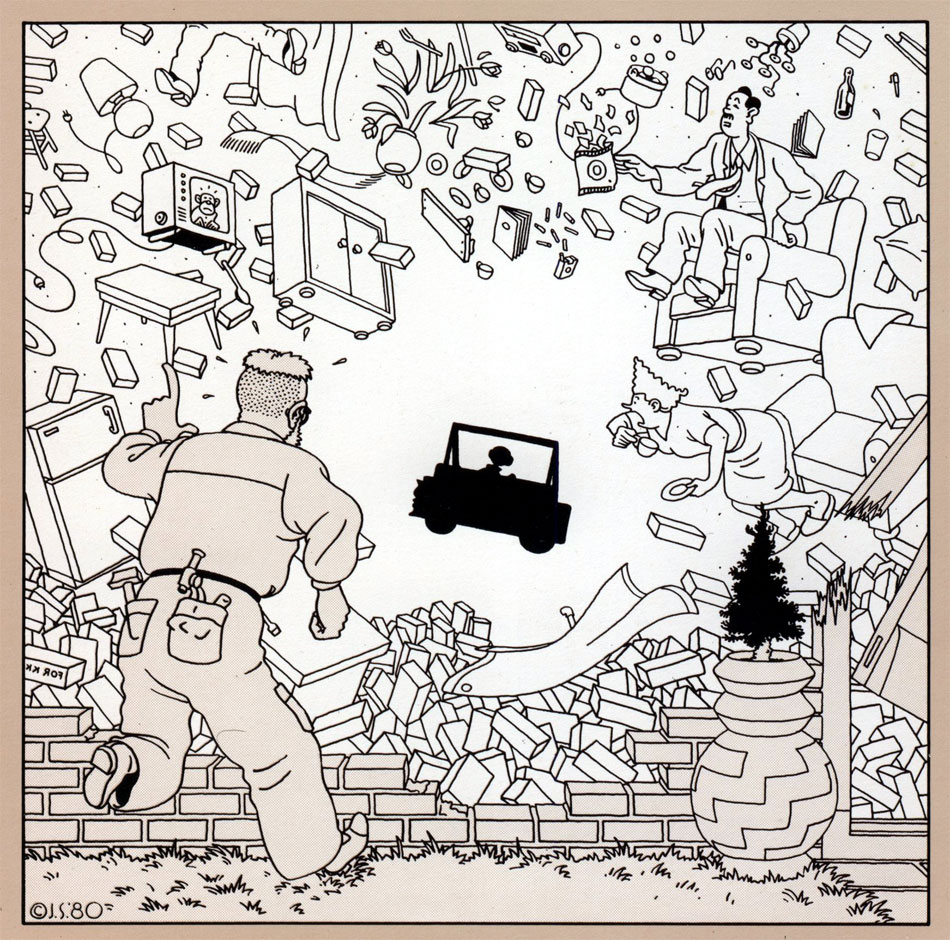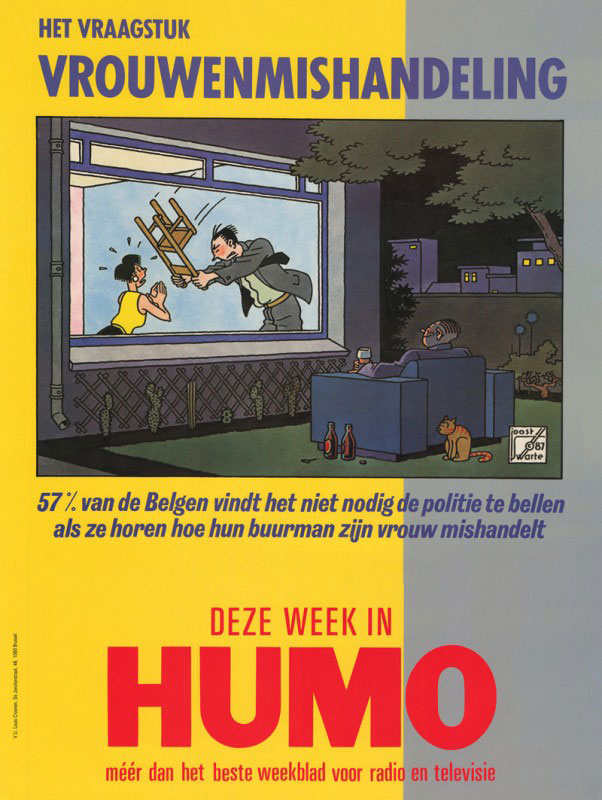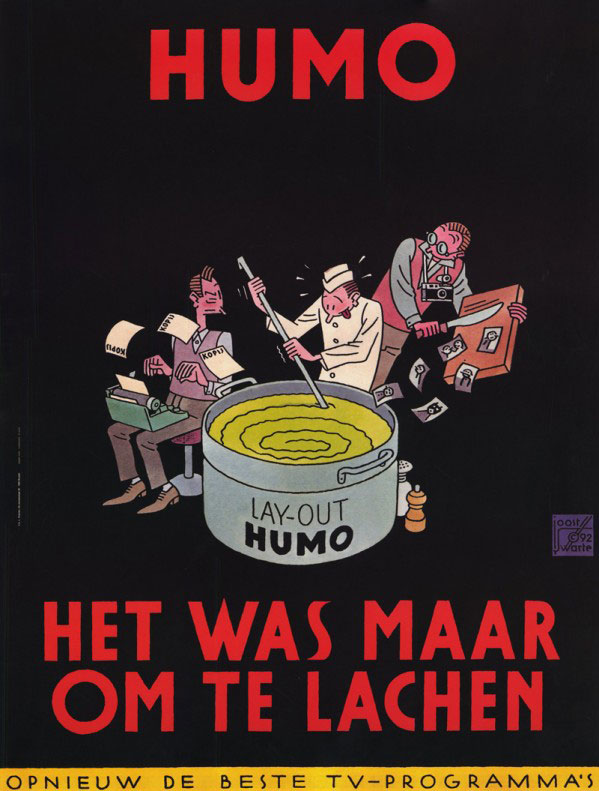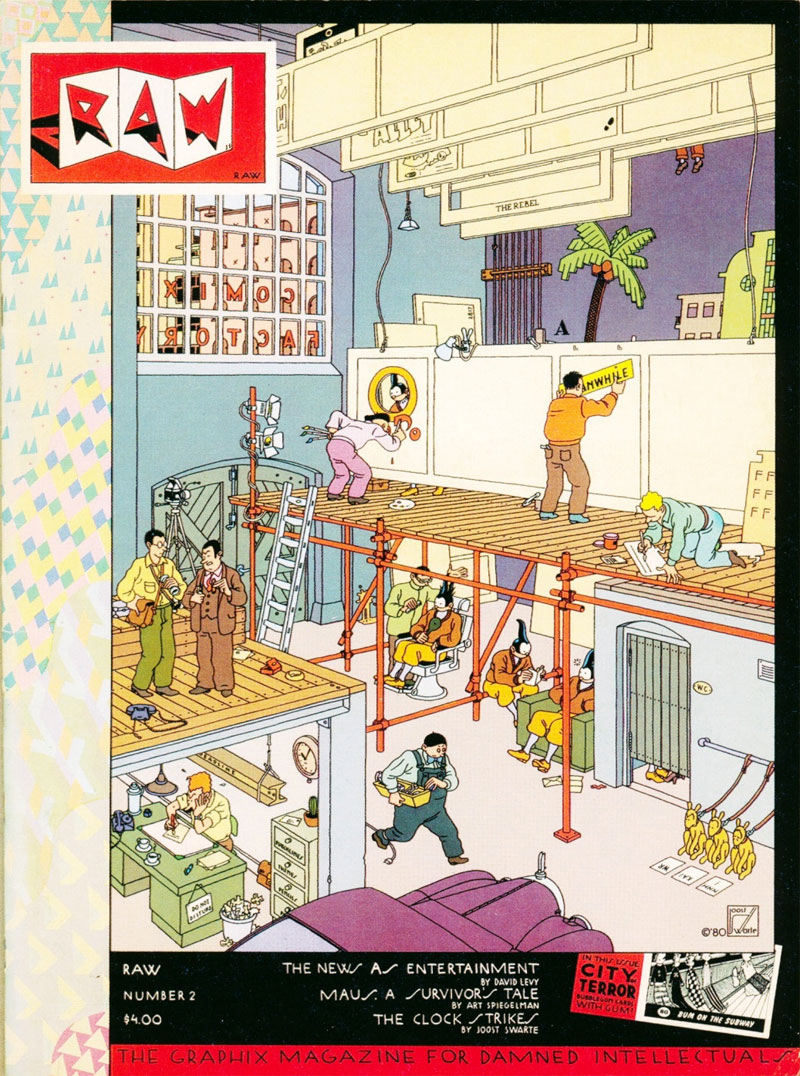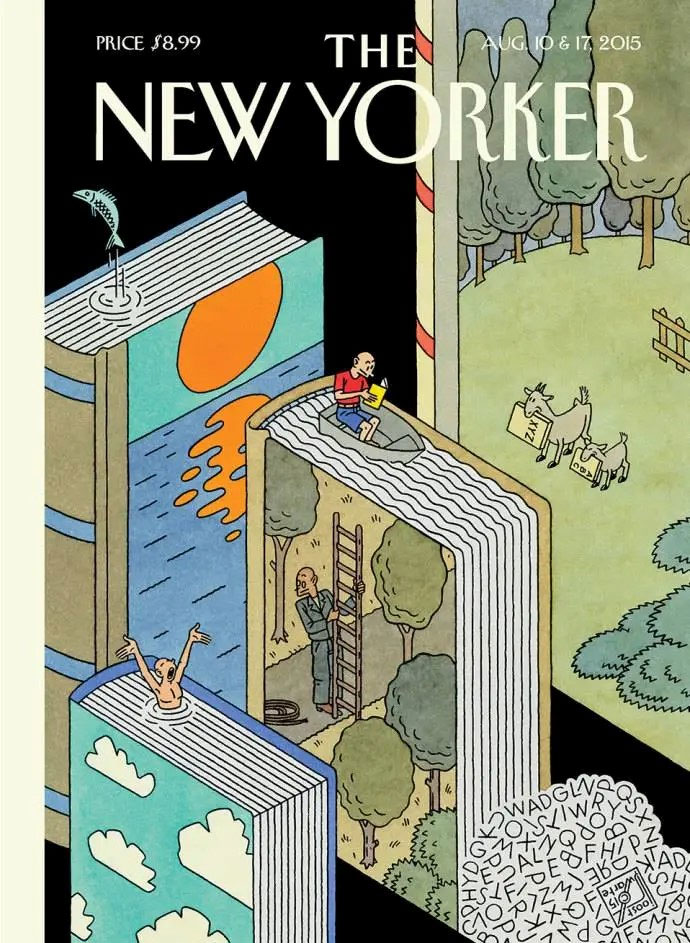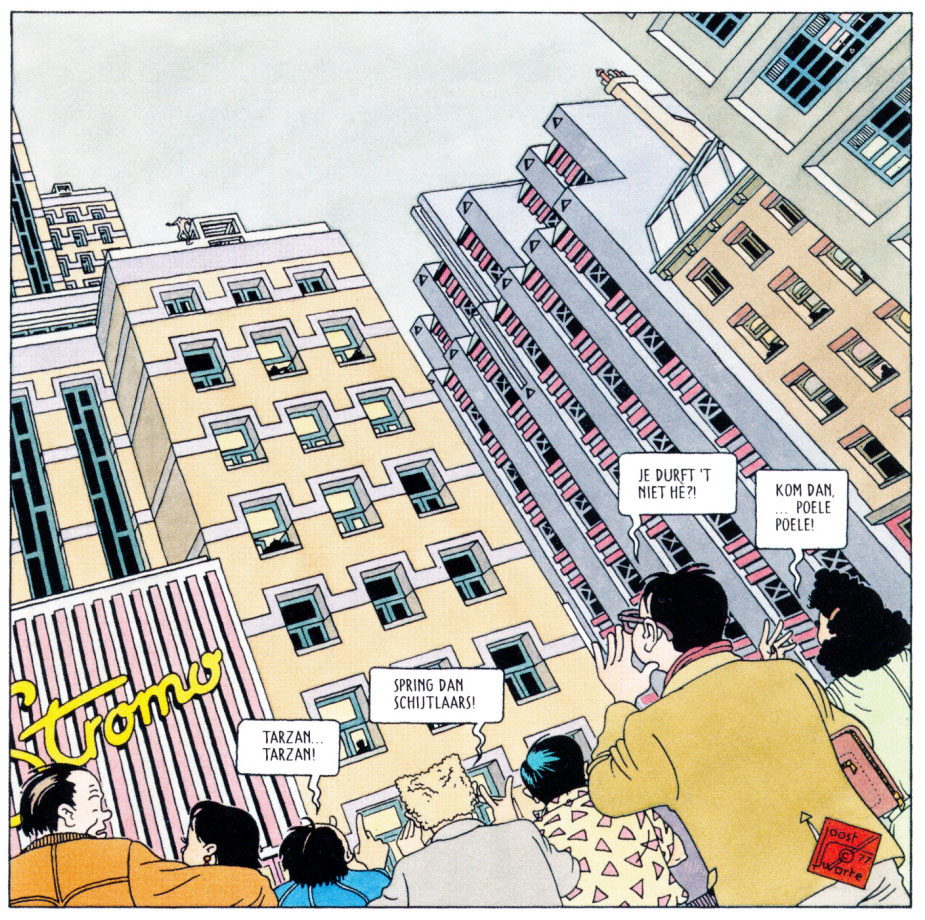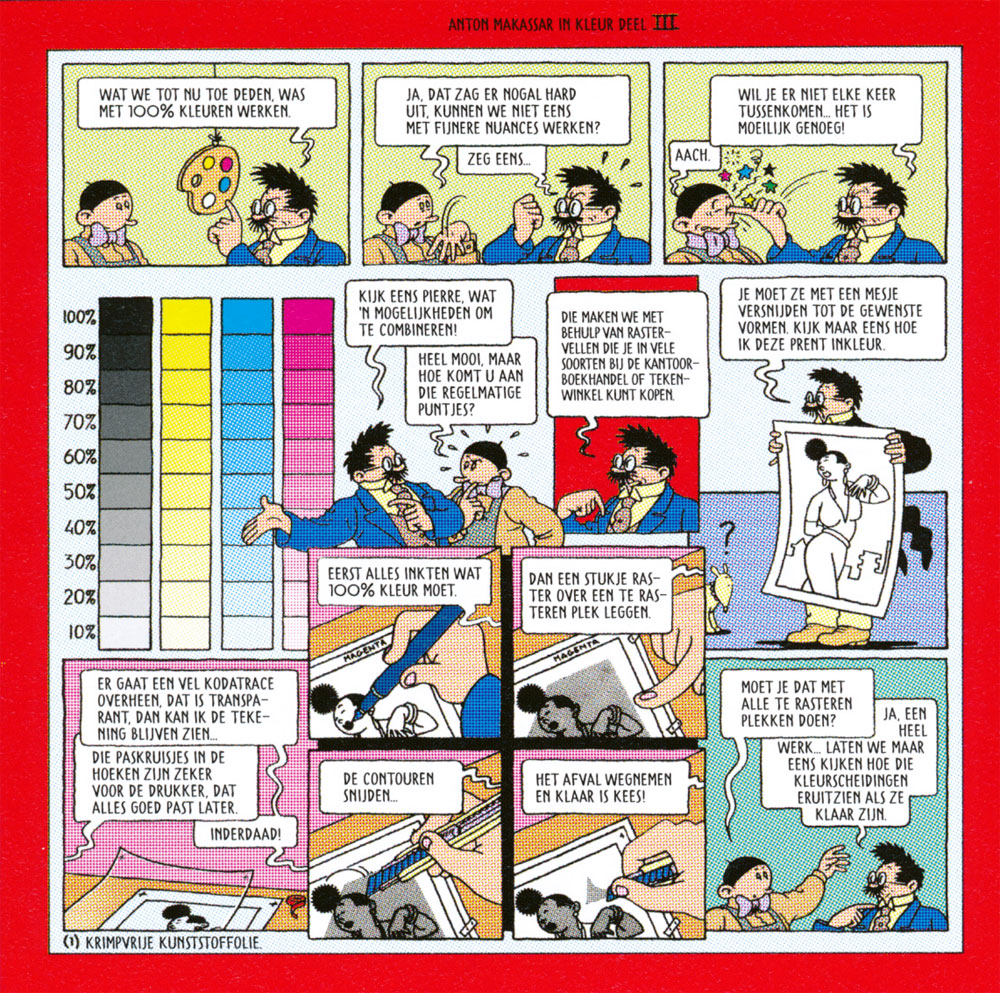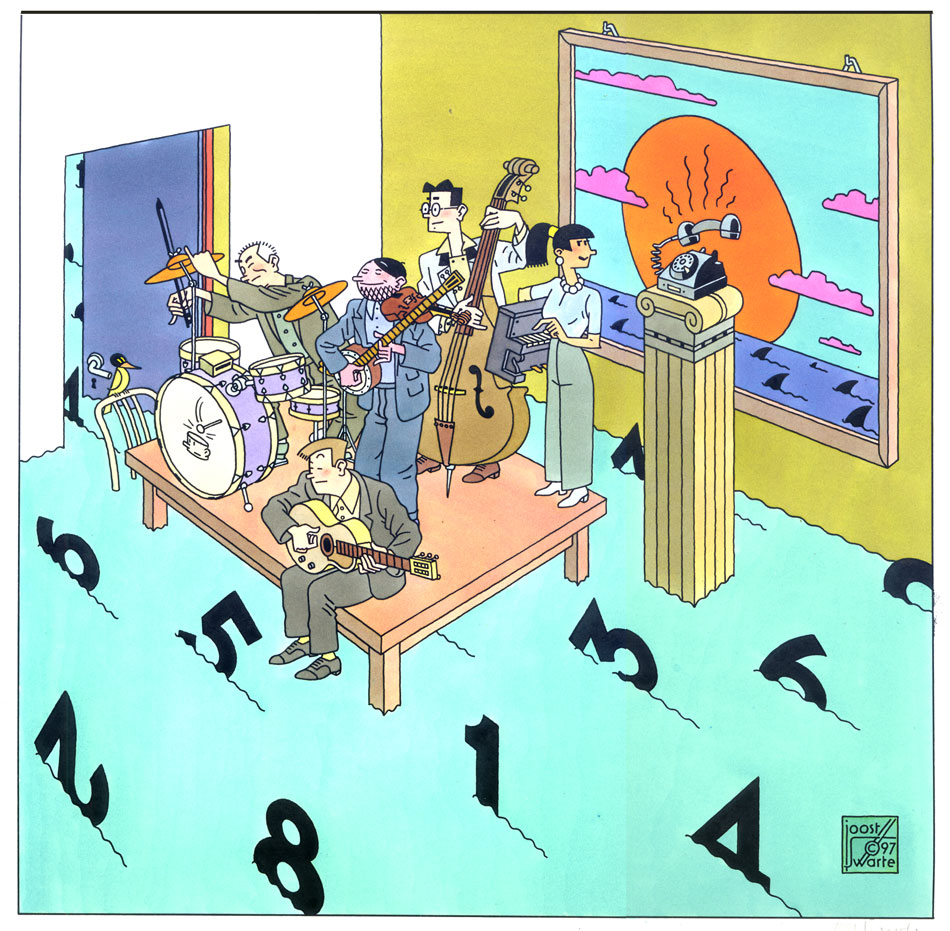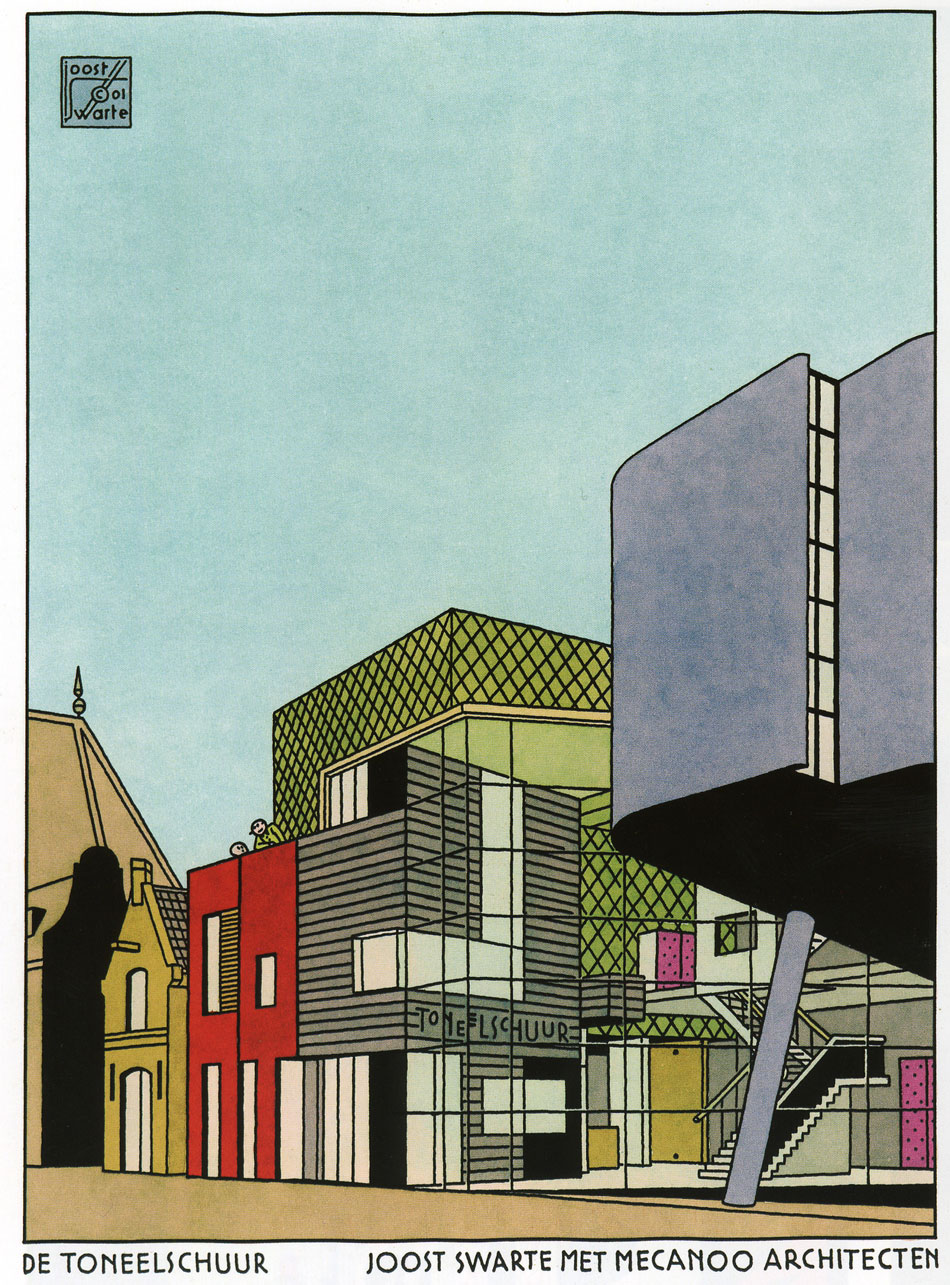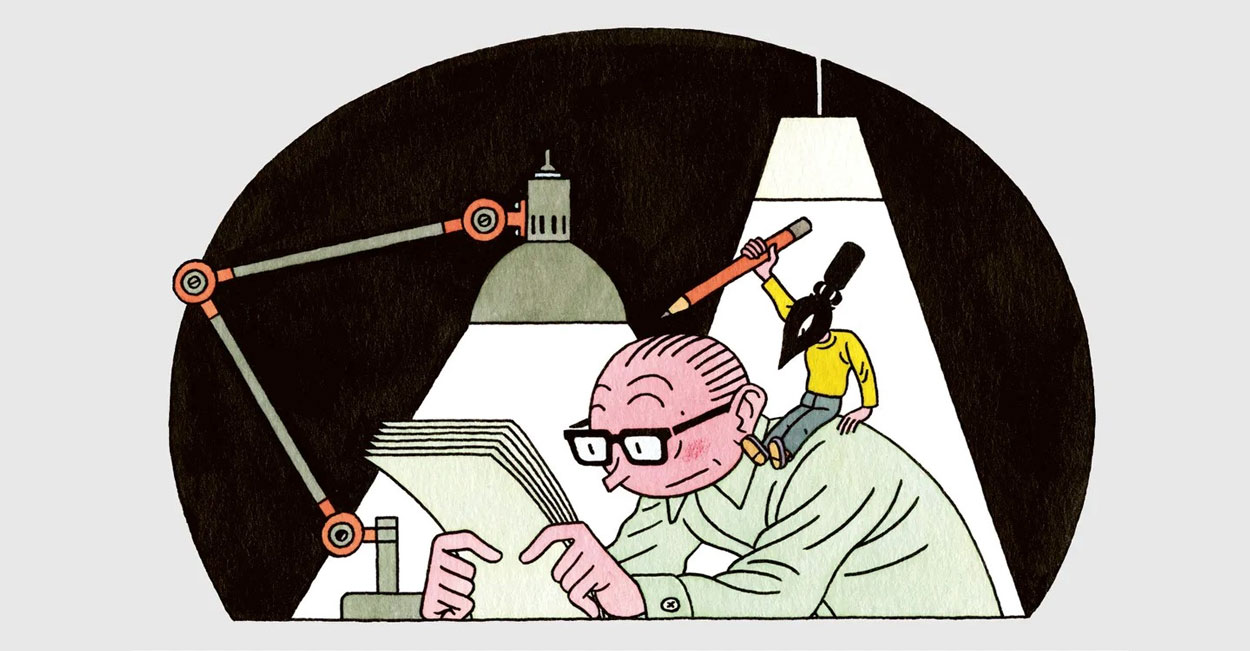'It Was A Dark and Silly Night', from 'Little Lit: It Was A Dark and Silly Night' (2003).
Joost Swarte is an internationally renowned Dutch graphic designer, illustrator and architect, admired for his calculated and technically precise style, with much attention to elegant designs and bright colors. In the 1970s, Swarte drew underground comix stories featuring characters like the quiffed loafer Jopo de Pojo and the failed art collector Anton Makassar, as well as the children's adventure series 'Katoen + Pinbal (1972-1979). He was (co-)founder of the influential alternative comic magazines Modern Papier (1971-1972) and Scratches (2014-2018), which helped put a spotlight on a great many talented comic creators. Swarte was additionally one of the initiators of the Dutch comic festival Stripdagen Haarlem and, with Hansje Joustra, co-founder of the publishing company Oog&Blik (1984-2010). As an avid admirer of Hergé, Joost Swarte helped with the design of the Hergé Museum in the Belgian town Louvain-La-Neuve and also coined the term "Clear Line" for the characteristic graphic style of Hergé and his followers.
Early life and influences
Joost Swarte was born in 1947 in Heemstede, a town in the province of North Holland. His family on his father's side were descendants of Jewish immigrants who had settled in Groningen in previous centuries, changing their family name from "Suarto" to "Swarte". His mother's family were Belgians who, during the First World War, fled from their hometown Merksem to The Netherlands, where they remained after the war. Joost Swarte's father was a salesman, his younger brother Rieks (Henricus Martinus, b. 1949) later gained notability as an actor, director and set designer. His maternal grandfather was Belgian-Dutch composer Jos de Klerk (1885-1969). Swarte credited his grandparents and their Belgian roots for his lifelong passion for, particularly Belgian, comics. During summer vacations, his family often spent their holidays with relatives in Flanders and Wallonia, which gave Swarte access to comic magazines like Tintin and Spirou. One time, he liked a particular 'Gaston Lagaffe' gag by André Franquin, which he wanted to show to his friends in his Heemstede neighborhood. But since he couldn't take the book with him, he simply redrew the entire page of a sheet of paper to take home with him.
Among Joost Swarte's earliest graphic influences were Carol Voges, Jean de Brunhoff, Hergé, Edgar P. Jacobs and Bob van den Born. He particularly admires the clean, bright artwork of Hergé, Jacobs and other realistic artists in Tintin magazine. Swarte also enjoys early to mid-20th-century comic pioneers with a similar graphically refined style, like Gus Bofa, John Held Jr., Milt Gross, Roy Crane, Winsor McCay, George McManus, George Herriman, Frederick Burr Opper, Alain Saint-Ogan and Will Eisner. In the late 1960s, he discovered underground comix and was highly influenced by the taboo-breaking, adult stories of Robert Crumb, Skip Williamson, Jay Lynch, Justin Green, Kim Deitch, Bill Griffith and, from his own home country, Willem. Later in his career, Swarte expressed admiration for Ever Meulen and Tobias Tak. Growing up in the home country of highly intricate, innovative and globally influential architects and designers like M.C. Escher, Gerrit Rietveld and Theo van Doesburg, Swarte also developed interest in these artforms. Art movements that have influenced Joost Swarte in his work have been De Stijl, Bauhaus, Futurism, Dadaism and Surrealism. Another notable influence is the French filmmaker Jacques Tati, whose perfectly orchestrated 1967 film 'Playtime' is Swarte's favorite.
Swarte enjoyed drawing from a young age, but still took another route for his education. He studied industrial design at the Academy of Design in Eindhoven, making illustrations for local papers like De Andere Krant and Uit De Kunst. However, in 1969, after three years, Swarte dropped out, becoming more interested in comics and illustrations. He settled in the city of Haarlem, not far from his birth town of Heemstede.
Cover illustrations for Modern Papier, respectively January 1971 and late 1972.
Modern Papier and other alternative comic publications
In 1969, Swarte's first comic strip 'Het Ware Verhaal van Mr. P.' was published in De Andere Krant, an alternative magazine distributed in Eindhoven. The character Mr. P is a strange man with a lightbulb-shaped nose and a dollar sign on his high hat. Swarte later reused him in his next project, his own comic magazine Modern Papier (1971-1972), for which Swarte drew one-shot stories like 'Design Dealer Presents', 'Hektor', 'Mr. P.' and 'De Bros'. Besides his own work, Modern Papier also printed work by other artists, ushering in a new generation of Dutch alternative comic creators. Among the contributors to Modern Papier were Bill Bodéwes, Rob Figee, Evert Geradts, Bob Heiligers, Ever Meulen, Peter Pontiac, Jan Schoen, Mark Smeets, Jacques Verbeek, Sander Wissing and the future filmmaker Dick Maas. Modern Papier lasted 10 issues, all self-published by Swarte, until merging with another influential underground comix magazine.
In 1972, Swarte's underground comix magazine joined forces with Tante Leny Presenteert, edited by Evert Geradts. Swarte continued to contribute comic stories to Tante Leny until 1975, and additionally contributed to the underground weekly Aloha (1971-1974), the news magazine De Nieuwe Linie, the comic fanzine Inkt, and the Dutch underground comic anthology 'Cocktail Comix' (Tango, 1973), which he edited himself. In 1976, he started his collaboration with Piet Schreuders' magazine Furore. While most of Joost Swarte's comics output was limited to the 1970s, Swarte continued to create an occasional comic story in the following decades. He was also closely affiliated with the Real Free Press of Olaf Stoop, who, in 1980 released a collection of Swarte's comics, called 'Modern Art'. Swarte additionally made the designs for the Real Free Press editions of the work of classic American newspaper artists like George Herriman, Winsor McCay, Gustave Verbeck, Percy Crosby, Basil Wolverton and George McManus.
'Caesar Soda?' (Cocktail Comix, 1973).
While the American underground comix movement inspired alternative artists to create autobiographical, self-reflexive comic stories with non-conformist, daring artwork, Joost Swarte instead used traditional European comics as guideline for a string of short stories and gag pages filled with sex, extreme violence and absurdities. With clean visual storytelling inspired by Hergé, Swarte created satirical takes on colonialism in the stories 'Het Wachten is op Versterking' (1972) and 'Caesar Soda? (1973), or absurd tales about a wave of suicides in the city ('Goodbye', 1977), a modern-day Tower of Babel ('Een Tweede Babel', 1986) and a Rubber Paradise for retired condoms ('Het Rubber Paradijs', 1991). Many Swarte comics breathe the atmosphere of a classic adventure story, but then with weird twists, outlandish plot developments and lack of traditional endings. On rare occasions, Swarte took a political stance, like with the comic strip 'Activo Aventura Argentina', that protested against the organization of the 1978 World Championships Football in Argentina, which was a military junta at the time.
Jopo de Pojo, Anton Makassar and other characters
Recurring characters in Swarte's alternative comic stories are Jopo de Pojo and Anton Makassar, alongside more sporadic creations such as the Blue Berbers ('De Blauwe Berbers') and Pierre van Genderen, a stupid but sympathetic handyman, who always walks around in overalls and a beret. Swarte's most recognizable character is however Jopo de Pojo. Much like Hergé's 'Tintin', Jopo has a quiff and golf pants, though in his case his hair is black, much longer and curls backwards instead of forwards. Swarte was inspired by the faces and costumes of The Marx Brothers and felt his own character should also have a distinctive look. Apart from Tintin, Jopo also has a sign on his shirt, referencing George Herriman's 'Krazy Kat', while his face brings up comparisons with Walt Disney's Mickey Mouse and Otto Messmer's Felix the Cat. An unlucky loafer, Jopo goes on weird adventures, but often ends up on the receiving end. In one classic gag, Jopo visits a publisher to present a comic that can be read rightside up and upside down, while the actual comic he appears in himself has the same gimmick. Swarte made it as a tribute to early 20th-century comic artist Gustave Verbeck and his 'The Upside Downs of Little Lady Lovekins and Old Man Muffaroo' (1903-1905). Other episodes of Jopo are visualizations of blues lyrics.
Cover illustration for the 'Anton Makassar' book 'Modern Art' (1980).
Another often-used character in Joost Swarte's work is Anton Makassar, a modern artist and art expert, used to spoof all the pompous, pretentious brouhaha of the art industry. Anton uses very complicated, antiquated language to hide the fact that he has no clue what he is talking about. Swarte also used the character in his 1975 graphic novel 'De Papalagi', based on the controversial book 'Il Papalagi' (1920) by German novelist Erich Scheurmann. Scheurmann claimed that he had interviewed a Samoan chieftain about life in Europe. His primitive observations were presented as true accounts, but nowadays it is generally agreed that Scheurmann came up with everything himself. This made the story perfect material to be presented through Anton Makassar's lens. Swarte's 'De Papalagi' sold well, also because its anti-technology and pro-environmental sentiments were popular viewpoints among the youth in the 1970s.
Katoen + Pinbal
In 1972, Swarte acquired a more mainstream audience through his cover illustrations for the Malmberg school magazines Okki and Jippo. Between 1972 and 1979, these magazines also ran his comic feature 'Katoen+Pinbal' (1972-1979). Katoen is a clown in a Pierrot costume, and Pinbal his anthropomorphic pet dog. The characters are reminiscent of Max Fleischer's Koko the Clown and Bimbo the Dog. Originally, Pinbal was a little dog who walked on all fours, but Swarte later redesigned him as a human with a dog face, sharing the same size as the human characters. A third character is Zacharias the mouse, who also grew in size. In February 1977, Joost Swarte passed on the drawing pen of the feature to his friend Flip Fermin. From Swarte's script, Fermin embarked upon the serial 'Huize "Bel-Air"', but had difficulties meeting his deadlines and the story was aborted after 23 pages. Swarte then resumed drawing the comic by himself. For a while, Jan Vervoort was considered to continue 'Katoen + Pinbal', but eventually these plans fell through. 'Katoen + Pinbal' was also translated into French as 'Coton et Piston' and ran in the British children's magazine Measles under the title 'Hector and Dexter'.
'De Wereldreis van Rik en Klaartje' (1980).
Collaborations
As early as 1974, Swarte had some of his work published in Charlie Mensuel in France, teaming up with the Dutch cartoonist Willem to create a story featuring Willem's petty thief 'Fred Fallo' (issue #64). Later that decade, he also published in Willem's short-lived magazine Surprise (1976). Between 26 April and 11 October 1980, Swarte illustrated 'Wat Heb Ik Nou Aan Mijn Fiets Hangen?', a story written by Willem and published in the Dutch magazine Vrij Nederland. The story stars two kids, Rik and Klaartje, who travel the world in their special car. Most of the dialogue features satirical commentary about the countries they visit, but presented in the style of an old-fashioned children's book about exotic adventures. In 1982, the story was published in book form as 'De Wereldreis van Rik en Klaartje' (De Harmonie, 1982), with a French translation under the title 'Le Tour du Monde de Ric et Claire' (Futuropolis, 1982) and a German one as 'Klara und Ricky: Eine Reise um die Welt' (Édition Moderne, Zürich, 1983).
Joost Swarte was one of the artists involved in the collective 'Toon en Toos Brodeloos' feature, which a team of seven artists produced in 1976 for VPRO-Gids, the magazine of broadcasting organization VPRO. Each episode was a satirical story about one of the Dutch broadcasting organizations, drawn by a different artist. Swarte did the one about AVRO, while the other artists were Evert Geradts (KRO), Aart Clerkx (VARA), Joost Troost (EO), Rob Gorter (NCRV), Harry Buckinx (VPRO) and Fred Julsing (TROS). The stories were collected in a book by Har van Fulpen's Drukwerk in 1976.
Magazine features
As his activities expanded to a variety of art forms, Swarte continued to work regularly for the Dutch mainstream press, most notably the opinion weekly Vrij Nederland. For this magazine's children's paper, Swarte drew the comic strip 'Dr. Ben Ciné (March 1978 - April 1980). Each episode features a doctor called Ben Ciné (whose name is a pun on the Dutch word for gasoline, "benzine"), being confronted with strange patients and other odd people coming his way. Book compilations were released in 1986, 1987 and 1991 by De Harmonie/Het Raadsel, with French translations published by Futuropolis. Also for Vrij Nederland, Swarte made the two-panel cartoon feature 'Niet Zo, Maar Zo' (1982-1990), parodying educational comics. Each gag demonstrates to readers the "bad example" of an absurd situation, as opposed to the "good example". In 1985, De Harmonie/Het Raadsel released a book compilation, translated into French by Futuropolis as 'Passi Messa' and in German by Affholderbach & Strohmann as 'Nicht so sondern so!'.
In March 2011, Swarte returned to comics with 'Leven op Orde', serialized in the monthly magazine Hollands Diep. These one-page gag comics feature absurd reflections on life, like a couple rearranging their household until it is reduced to just a cramped cabin. The gags were also translated into English (as 'We'll Make It' in The New Yorker) and French ('Marie de la Coiffeuse'). In 2012, a book compilation was released by De Bezige Bij/Oog & Blik.
Poster and cover art for Humo magazine (1987 and 1992).
International career
Starting in the mid-1970s, Joost Swarte steadily gained international recognition. After having some of his work published in the French magazine Charlie Mensuel, he became a recognizable cover illustrator for the Flemish weekly Humo. Active for Humo between the late 1970s and early 1990s, he also livened up the pages of the official guides for the Humo-sponsored Torhout-Werchter rock music festival. He designed the poster for the 1980 edition of Humo's Rock Rally, also used on an album compilation, and their 1994 'Basta' rock compilation album. His best-known illustration work for the magazine was the 'Kinderen Over...' series, of which the first installment appeared in 1989. In this irregularly appearing series, elementary school children are instructed to write their personal ideas about one central question, like "What do you think Heaven is like?", "What are you afraid of?"' and "What would you like to ask His Majesty?". The children's unintentionally naïve, charming and funny answers are deliberately printed with all spelling, punctuation and grammatical errors intact. The series was well-received by Humo's readers and was collected in a 1991 book compilation, 'Kinderbrieven aan de Koning' (Dedalus, 1991), also reprinting Swarte's original illustrations for the series.
Illustration accompanying the question "What do you think Heaven is like?" in Humo magazine.
In 1980, Joost Swarte took part in the international comic show Salon International de la Bande Dessinée in Angoulême for the first time, and in 1984, a survey of his work called 'Swarte, Hors Série' was published in France by Futuropolis. He has regularly made illustrations and covers for the influential US magazine The New Yorker, which also ran his strip 'We'll Make It'. For a 7 September 2006 cover of The New Yorker, he had to make an illustration about a Wall Street crisis regarding the Chinese Stock Exchange. Swarte drew a mouse crawling down a graphic, with his tail symbolizing a statistic, while a red cat (symbolizing China) ogles him below. While the design was accepted and ready for printing, Swarte received an urgent phone call from the editors: Wall Street had recovered from the Chinese economic troubles. Swarte quickly made a new drawing of a mouse crawling up, which his editors quickly added to the artwork as a replacement for the older mouse drawing.
In the USA, Joost Swarte also contributed to the comic anthologies RAW and Little Lit, edited by Art Spiegelman and Françoise Mouly. Swarte received the honor to illustrate the cover of the December 1980 issue of RAW (#2), which became one of his most famous drawings. Known as "the Comics Factory", the drawing visualizes the production of a comic in the form of a cheap film company, where each panel border and speech balloon are painted against a background curtain, while a group of identical actors, one for each panel, is being prepared for the shoot. Since 2003, Joost Swarte's work is also featured in the Italian architecture magazine Abitare.
Cover art for RAW #2 (The "Comics Factory", 1980) and the 10 August 2015 issue of The New Yorker.
Style
Originally, when Swarte debuted at the turn of the 1960s into the 1970s, he used an underground comix style, reminiscent of Skip Williamson. Interviewed by Kim Thompson and David Peniston for the The Comics Journal (5 November 2012), Swarte said that he liked Williamson's meticulous drawings, combined with the freedom of the underground press. After this phase, he rediscovered and revalued the work of Hergé, an artist whom he, like so many other European comic artists, had grown up with. He attributed Hergé's greatness to the directness of his crisp lines and bright colors, allowing for instant readability. Every background in Hergé's panels is stylized, but still realistically portrayed, with a believable, vivid feel. Influenced by cinematographic techniques, Hergé also contemplated on how to frame his pictures in function of the story he wanted to convey, another aspect Swarte admires about him. Many other Franco-Belgian comic artists in Hergé's magazine Tintin also used this style, which became known as "The School of Brussels", or under the name Swarte coined in 1977: the "Clear Line". Swarte also looked at the internationally renowned early 20th-century Dutch art movement De Stijl, whose rectangular, elegant buildings, furniture, paintings and sculptures combine functionality with stellar design. He admired the fact that representatives of De Stijl (like Gerrit Rietveld and Theo van Doesburg) didn't limit themselves to just one artform.
Swarte's own drawings have a calculated and carefully balanced look. Characters wander around in odd, but neatly constructed surroundings. Even the humans and animals follow strict geometry. Since Swarte's art is reminiscent of a classic comic strip, it has an instant mainstream appeal. Nevertheless, he subverts audience expectations by not giving them a traditional adventure or a gag with one punchline. Both as an illustrator and a comic artist, Swarte has been more interested in impressive, but bewildering imagery. The background designs, dazzling perspectives and precisely rendered objects, like buildings and cars, are the real treat. They show off clever creative ideas, like optical illusions and bizarre yet plausible constructions, all perfectly brought together in a styleful graphic composition. His work additionally contains numerous (graphical) references to classic American newspaper comics, African-American movie clichés and blues music.
As a comic creator, Swarte has put style over story. His dialogues typically use old-fashioned Dutch, a throwback to the comics he read as a child, which often featured words and expressions he didn't understand yet. Before and directly after World War II, many comics in Dutch children's magazines were sometimes badly translated, or written by adults who didn't quite know how to write for young audiences. This resulted in stilted dialogue, with archaic language that didn't quite match the straightforward action scenes. Although young Swarte didn't get every sentence, he was so enthralled by the images that he absorbed these antiquated dialogues nevertheless. In his own comics, he aimed for the same bewildering juxtaposition between speech balloons and imagery.
Simply calling himself a "creative soul", Joost Swarte never wanted to be pigeonholed in one artistic discipline. His art has adorned magazine covers, logos, murals, tiles, stained glass windows, stamps and other objects. Whenever he receives a commission, Swarte never starts out doing exactly what is requested of him. If, for instance, he has to create an architectural design, he will read a book about carpet calligraphy to help him get different creative ideas.
'Een tweede Babel' (1986).
Clear Line
Throughout his career, Swarte has studied and explored graphic styles and forms of visual storytelling. During a 1977 Hergé exhibition in Rotterdam, he coined the term "Clear Line" ("Ligne Claire"). He described the style through its use of clear lines of the same width, solid and bright coloring and no hatching, all to gain a maximum readability of the drawing. The style had its origins in the Brussels school of Hergé in the 1940s, but experienced a revival during the 1970s and 1980s, with Swarte as one of its main representatives. In the Netherlands, artists like Theo van den Boogaard, Dick Briel, Erik de Graaf and Eric Heuvel have applied the Clear Line in Swarte's footsteps. Yves Chaland, Ted Benoit, Serge Clerc and Jean-Claude Floc'h relaunched the style in France, while Chris Ware is one Swarte's main artistic followers in the USA. In Belgium, Joost Swarte's graphical counterpart can be found in Ever Meulen.
Over the years, Joost Swarte has made covers for several books and studies about Hergé and the Clear Line, starting with a 1977 series of essays by Ernst Pommerel and Har Brok to accompany the Rotterdam exhibition Kuifje in Rotterdam: 'Kuifje, Zijn Vrienden, Zijn Vijanden', 'De Klare Lijn', 'Kuifje Is Geen Enigst Kind' and 'Oostindisch Blind'. In his illustrated encyclopedic book 'Kop en Staart' (De Bezige Bij, 2014), Swarte gave an overview of all aspects of storytelling. From character to plot and from oxymoron to catharsis, all explained with the help of the three blind mice from the British nursery rhyme.
Meta episode of Anton Makassar, dealing with color separation, which he explains to Pierre Van Genderen (1975).
Comics promotion
Swarte has also established himself as an advocate and promoter of comics as an artform. Together with Hansje Joustra, the former owner of a punk rock label and store, Swarte founded the publishing company Oog & Blik, which since 1985 has been the home for many prize-winning Dutch graphic novels and alternative comic books, as well as the Dutch editions of Robert Crumb's work. In 2010, the Oog & Blik imprint was taken over by the literary publishing house De Bezige Bij. Since then, Swarte has served as an advisor for Joustra's further publishing endeavors at Scratch Books and Concerto Books. At Scratch Books, they launched the comics anthology series Scratches, containing work by both contemporary and classic Dutch, Flemish and international artists. The first volume was published in October 2016.
In 1992, Joost Swarte was also the initiator and host of the first edition of the Stripdagen Haarlem event, a prestigious comics festival with an artistic approach to the comics medium. Since then held biannually, the later chairmen of the event have been Joost Pollmann (1994-2014) and Tonio van Vugt (2016-2022). In 2000, Swarte designed an exhibition dedicated to Tintin in the Frans Hals Museum in Haarlem, which met with official approval from Hergé's widow Fanny Rémi and her second husband, the British lawyer Nick Rodwell. In fact, when a Hergé Museum opened in Louvain-la-Neuve in 2007, Swarte was part of a group of select people who helped with the design of the building, down to each room and exhibited artefact. Joost Swarte also designed the poster of 'Maîtres de la Bande Dessinée Européenne', an exhibition highlighting masters of European comics, held between 24 January and 25 April 2001 in the Centre National de la Bande Dessinée et de l'Image in Angoulême, France.
In addition, Swarte has organized comics courses at schools, for instance the Bos and Vaartschool in Haarlem. In 2012, he held his lecture 'Het Voorbeeldige Beeldverhaal' ("The Exemplary Cartoon") at the University of Breda, talking about 16 of his favorite comic artists (David B., Gus Bofa, Bob van den Born, Miguel Covarrubias, Will Eisner, Lyonel Feininger, Rube Goldberg, Hergé, George Herriman, Mark Smeets, Walter Trier and Basil Wolverton). In 2012, he also made a poster for the 8-9 June Comics exhibition in Oslo. On 23 June 2017, a mural designed by Swarte was presented in the Rouaanse Kaai in Antwerp, as part of the local Comics Route.
Graphic and written contributions
Swarte made a graphic contribution to Marion Vidal's 'Monsieur Schulz et ses Peanuts' (Albin Michel, 1976), an essay about Charles M. Schulz's 'Peanuts' strip, illustrated with subversive parodies of the comic, that Schulz unsuccessfully tried to sue. Swarte was also one of the artists making a graphic contribution for 'Pepperland' (1980), a collective comic book celebrating the 10th anniversary of the Pepperland comic book store. In 1983, he was one of many comic artists paying homage to the recently deceased Hergé in a special issue of (À Suivre), titled 'Adieu Hergé'. Swarte paid tribute to Zep's 'Titeuf' in 'Portraits de Titeuf Par 30 Auteurs' (Christian Desbois, Glénat, 2004) and to Ever Meulen during the October 2017 'Ever Meulen & Friends' exhibition in Brussels. Swarte contributed to Françoise Mouly and Art Spiegelman's 'Little Lit', namely 'Little Lit: Folklore & Fairy Tale Funnies' (2000) and 'It Was A Dark and Silly Night' (2003).
Joost Swarte also participated in several collective projects for charity causes. For Greenpeace, Swarte was one of the artists asked to make a contribution to 'Help, De Zee Verzuipt!' (Casterman, 1984), a book about environmental awareness. The same year he designed stamps for children, as part of the "Stichting voor het Kind" ("Foundation for the Child"). Swarte made a contribution to the collective comic book 'Cartoon Aid' (1989) of which the profits went to Amnesty International. He also contributed drawings to the "safe sex" promotional book 'Les Aventures de Latex' (FortMedia, 1991). He illustrated the lyrics to Mondo Leone's song 'Naakt en Kaal' for the 2006 collective comic album 'Strips in Stereo', and was also one of many artists making a graphic homage to a Dutch film in 'Filmfanfare. De Geschiedenis van de Nederlandse Film Verbeeld in 51 Strips' (De Bezige Bij/Oog & Blik, 2012). In 2015, he also contributed to a book honoring the assassinated cartoonists of the magazine Charlie Hebdo, 'La BD est Charlie' (Syndicate National de l'Édition, 2015). In 2020, Swarte joined 75 Dutch & Flemish comic artists to make a graphic contribution to 'Striphelden versus Corona' (Oogachtend/Uitgeverij L, 2020), a free collective comic book intended to support comic stores that had to close their doors during the lockdown at the height of the COVID-19 virus pandemic.
Swarte wrote a preface to the 2006-2007 reprints of Lo Hartog van Banda & Thé Tjong-Khing's comic series 'Arman and Ilva', published by Sherpa. He also penned a foreword to 'E' (Oog & Blik, 2010), the second volume in the compilation series of Windig & De Jong's 'Heinz' strips. He provided the foreword to a 2019 reprint of Milt Gross,' 'He Done Her Wrong', released in French as 'Deux Manches et la Belle' by the Table Ronde Hors Collection. He designed the cover for Peter van Dongen's graphic novel 'Rampokan-Java' (1998) and provided art direction to Tobias Tak's 'Canciones' (Scratch Books, 2017).
Artwork by Swarte promoting literature.
Books
Swarte livened up the cover of the book 'Enkele Interviews' (Dupuis, 1981) by rock journalist Marc Didden, collecting some his favorite full-length interviews for Humo magazine. He additionally illustrated Doeschka Meijsing's 'Ik Ben Niet in Haarlem Geboren' (De Vrieseborch 1985) and Stefan Themerson's 'De Hoofdinspecteur en de Ultra-Intelligente Machine' (De Bezige Bij, 1988). For reprints of Nescio's books 'De Uitvreter', 'Titaantjes' and 'Mene Tekel', published by Van Nijgh & Van Ditmar, Swarte also provided artwork. He made the cover for a Dutch translation of David Leavitt's 'A Place I've Never Been', in 1990 released by De Harmonie as 'Waar Ik Nooit Geweest Ben'.
In 1990, Swarte designed 'De Allermooiste Boeken voor Kinderen', a book collecting a series of articles about the best children's books from NRC Handelsblad, published by department store De Bijenkorf. Swarte is the author of 'En Toen De Stijl - Op Bezoek in het Atelier' (Leopold, 2017), in which he imagines what the studios of 10 artists of the art movement De Stijl would have looked like if they designed these rooms according to their signature styles. The book is partially educational, but also a personal homage to the artists Theo van Doesburg, Vilmos Huszár, Bart van der Leck, Piet Mondriaan, J.J.P. Oud and Gerrit Rietveld. It was published by Leopold in collaboration with the Municipal Museum of The Hague coinciding with an exposition on the occasion of the movement's 100th anniversary.
Album cover for Fav Losky's 1997 albums 'Numbers'.
Album covers and other musical collaborations
Also a big fan of music, Swarte once performed in the pop group The Shark, but after two concerts he decided that his vocals left a lot to be desired. While his own musical career was cut short, he continued to create cover illustrations for a great many musical albums, starting with The Mr. Albert Show's 1971 album 'Warm Motor'. In the late 1970s and early 1980s, he illustrated records for acts on Hansje Joustra's punk label No Fun (later Torso), including The Helmettes, Houseband, Mecano and Neon. On other punk labels, he created artwork for The Rousers and Squits. Besides punk, he illustrated the covers of blues rock compilation albums like 'Light Up The Dynamite' (1977) and 'Boem' (1996), and the 1978 Bintangs album 'Rhythm & Blues'. As an admirer of Argentine tango and latino music, he used his graphic talent to illustrate album sleeves for Tango Cuatro, Color Tango, Fuzué, Piano Con Clave, Capelino & Stéphane Grappelli, Osvaldo Pugliese & Astor Piazzolla, Sexteto Canyengue, Javier Fatta & Sexteto Canyengue, Septeto Turquino, Pascal Comelade and Eric Vaarzon Morel, as well as two volumes of the compilation album 'Lucho Collected' (1994, 1996). Joost Swarte also provided artwork for classical music, jazz & swing compilations like 'Zeit Für Liebe' (1993), 'Traveller' (1993), 'Romantics' (1993), 'Country Living' (1993), 'Sonntags-Konzert' (1993), 'Dinner By Candlelight' (1993) and 'Relaxation' (1993), as well as records by the Fra Fra Big Band, Lucas van Merwijk & His Cu-Bop City Big Band and Nueva Manteca.
'Jopo de Pojo' story illustrating the lyrics of Albert King's blues song 'I'll Play The Blues For You'.
His art adorned the hip-hop maxi single 'Feel the Draft' (1993), the Amsterdam song collection 'Amsterdam Zingt' (2000) and 'Ik Ben Jouw Man' (2018), a Dutch-language cover album of Leonard Cohen songs. In addition, Swarte designed the record covers for the Bert van Leeuwen Band's 'Kerstmis' (1988), Drs. P's 'Het Praatcafé van Drs. P' (1990), John Williams & The Boston Pops Orchestra's 'Movies' (1993), Paul de Leeuw 's 'Stille Liedjes' (1999), Ocobar & Geert Chatrou's 'Chatroubadour' (2005), Eero Jones & Kahvi's 'Vuosi', 1998) and the spoken word album 'Grote Verwachtingen (Opgroeien in De Letteren)' by Pieter Steinz.
In 1991, Swarte worked with Dutch musician Fay Lovsky on her albums 'Jopo in Mono' and 'Jopo in Mini', based on Swarte's comic character Jopo de Pojo, which featured artwork by Swarte to illustrate the CD box and the song lyrics. He also livened up the sleeves of her albums 'Fay Lovsky & La Bande Dessinée' (1996), 'Unfinished Business' (1996) and 'Numbers' (1997), while Piet Schreuders provided art direction. He also worked regularly with the Dutch electronic music duo Arling & Cameron, writing a couple of songs for their 1998 album 'Sound Shopping', while also designing the record cover and that of the single 'Jealousie'. In 2000, he was one of several graphic artists to contribute artwork to Arling & Cameron's 'Music for Imaginary Films' (2000). With his publisher friend Hansje Joustra, Swarte collected all of Robert Crumb's album cover illustrations into a book, 'The Record Cover Collection' (1995), accompanied by a CD collecting several of Crumb's favorite songs.
Poster for the 2001 Angoulême Comics Festival. Among the silhouettes are Benito Jacovitti's Cocco Bill, a World War I soldier from Jacques Tardi's 'It Was The War of the Trenches', Wilhelm Busch's Max & Moritz, André Franquin's Gaston Lagaffe, Hergé's Tintin and Snowy, Alain Saint-Ogan's Alfred the penguin, Raymond Macherot's Anthracite and Chlorophylle and Jean-Marc Reiser's Grosse Déguelasse.
Posters and thematic illustrations
Swarte designed the poster for the 1986 edition of the Mallemunt animation festival in Brussels and the 'Twist et Scooter. Rock Cinéma B.D.' exhibition in Parc Marignac (9-11 September 1985). He also made a poster for the 1989 and 1998 editions of the Holland Animation Film Festival. He graphically promoted the LGBT event 'Roze Zaterdag' (29 June 1996) and the 2001 National Youth Theater Day. For the pavilion of the Dutch government at the 2002 edition of the Floriade garden festival in Haarlemmermeer, he made 25 illustrations, also compiled into the book 'De IJzeren Lijn', published by Oog&Blik/De Harmonie. To celebrate the 2007 centennial of the Nederlandse Boekverkopersbond (Dutch Booksellers Foundation), Joost Swarte made a special illustration.
For a 2011 exhibition around the concept "traffic and transport" in the gallery Champaka in Brussels, Swarte made seven illustrations about artists with a close connection to this theme, namely Hollywood stars Audrey Hepburn, Buster Keaton, Groucho Marx, Jacques Tati, graphic designer Gerrit Rietveld, architect Le Corbusier and author-poet-mathematician Raymond Queneau. In 2014, Swarte designed chocolate coins for the public library of Gouda, located in a former chocolate factory. In 2020, Swarte made a poster for a special radio event on ZandvoortFM to give listeners some solace during the depressing COVID-19 pandemic, 'Haarlem Verslaat Corona'. Artwork and designs by Joost Swarte can be seen throughout the city of Haarlem, for instance in the logo of the local french fries brand and snack bar FrietHoes.
The Toneelschuur in Haarlem, designed by Joost Swarte.
Architectural, furniture designs and sculptures
As a designer of furniture, Swarte is famous for his so-called "carrot-table", a glass table held up by four big carrot-shaped legs. He also designed children's furniture for the Van Reekum Museum in Apeldoorn. In architecture, he has made his mark by designing the Toneelschuur theater in Haarlem. He has applied himself to making stained glass artwork, used in the design of several housing blocks in the Marnix Street in Amsterdam (1999), a window for the Palace of Justice in Arnhem (2004), the Bakenesserkerk in Haarlem (2013), the Oosterkerk in Hoorn (2021) and a swimming pool in Breda. On 1 May 2015, Swarte decorated a sculpture of Dick Bruna's literary character Nijntje ('Miffy') for the Art Parade in the Hortus Botanicus in Amsterdam. He additionally made a sculpture of a mythological horse, 'Weer en Wind en het Mythische Paard' (2009), based on a local legend, for the town of Slochteren. Since 2010, the Willemsstraat 204-210 in Amsterdam has a "Joost Swarte House", a rental apartment building designed by Joost Swarte by commission of the Ymere housing corporation.
Recognition
In 1981, Joost Swarte was given the Prix Saint Michel for "Best Foreign Artist" by the city of Brussels. On 20 September 1985, Swarte and the Dutch postal service PTT received the Annual Award for Special Merits from comic appreciation society Het Stripschap (the "Jaarprijs voor Bijzondere Verdiensten", nowadays the P. Hans Frankfurtherprijs) for the special 1984 comic stamps. In Germany, Swarte's comic 'Niet Zo, Maar Zo' received the 1988 Max & Moritz Award. On 30 October 1990, Swarte received the Stripschap's Annual Award for Special Merits again, awarded during the Stripdagen in Breda. Eight years later, on 10-11 October 1998 during the same event, he received the Stripschap Prize for his entire body of work and his contributions to comics in general.
Stamps designed by Joost Swarte in 1984.
Joost Swarte's 1994 poster for the Holland Animation Film Festival received the Prix Jules Chéret (1995). In 1999, his design for Peter van Dongen's graphic novel 'Rampokan-Java' received the "Dutch Prize for Best Book Design". On 30 April 2004, Swarte was knighted in the Order of Orange-Nassau. Communications Arts Magazine gave him the "Award of Excellence" for his 20 August 2007 cover of The New Yorker. On 6 June 2012, he won the Dutch Marten Toonder Prize and on 21 November 2022 the Grand Boum de Ville de Blois in France, both for his entire comics oeuvre. On 4 October 2022, the Kunststuk Foundation bestowed Swarte with the Antithese Prize, an award given to a Haarlem artist who contributed to the architecture and design of the city. On 21 June 2018, Swarte's book 'En Toen De Stijl' (Leopold, 2017) received the "Vlag en Wimpel Award" for "Best Children's Book".
Exhibitions
Since 1974, Joost Swarte's work has frequently been exhibited. His work could be viewed in the Art Shop in the Palace of Fine Arts in Brussels (7 November - 21 December 1986). The Galerie Année in Haarlem organized 'Joost Swarte en de Negen Kunsten', during the local Stripdagen event (30 May-23 June 1996). Between 5 May and 2 September 2007, the bi-lingual expo 'Chapitres/Hoofdstukken' appeared in the Musée d'Art in La Louvière, Belgium. Between 1 September and 8 November 2009, 'De Wereld van Joost Swarte' ("The World of Joost Swarte") was on display in the Grafisch Museum in Groningen and subsequently traveled to Budapest and Pécs (Hungary), New York and Brussels. To celebrate his fifty years as an illustrator, the exhibition 'Joost Swarte Overal' appeared in the Kunsthal Rotterdam from 14 September 2019 until 19 January 2020. Between 3 June and 30 October 2022, the Teylers Museum in Haarlem exhibited book illustrations by Joost Swarte.
Legacy and influence
Joost Swarte is a towering figure in both the Dutch and international world of comics and graphic art. Many underground and alternative artists owe their careers to him promoting them through magazines like Modern Papier, Cocktail Comix and Scratches. In the Netherlands, Joost Swarte was a notable influence on Erik de Graaf, Michiel de Jong, Auke Herrema, Erik Varekamp, Roel Venderbosch and Wouter Winter. He was also admired by fellow countryman and cartoonist Theo Gootjes. In Belgium, he counts Kim Duchateau, Ben Gijsemans, Jean-Louis Lejeune, Ever Meulen and Katrien Van Schuylenbergh among his disciples. In France, he inspired Blexoblex, Ted Benoît and Mathieu Laville. In the United States, he influenced Charles Burns, Dan Schiff and Chris Ware and drew admiration from Art Spiegelman and Françoise Mouly. In 2016, the comic store Jopo de Pojo (previously Silvester Strips) in Haarlem named itself after Swarte's character of the same name, who is also featured in the store logo. Joost Swarte's daughters have all worked in media, Woody as a freelance editor/journalist for newspaper De Telegraaf, Suze (b. 1990) as a graphic designer and Loulou (b. 1992) as a voice-actor.
Books and documentaries about Joost Swarte
A compilation of Swarte's comics work was published under the title 'Bijna Compleet' ('Nearly Complete') by Oog & Blik in 2011. This collection was also published in France ('Total Swarte'), the USA ('Is That All There Is?'), Spain ('Casi Completo') and Norway. The Dutch broadcasting organization VPRO devoted the TV documentary 'Swarte & Swarte' (2001) to Swarte and his brother Rieks, directed by Grietje Keller, as part of their documentary series 'Het Uur van De Wolf'.
Lambiek will always be grateful to Joost Swarte for illustrating the letter "K" in our encyclopedia book 'Wordt Vervolgd - Stripleksikon der Lage Landen' (1979), for organizing our store's very first exhibition on 18 October-November 1986 and designing and editing the 2008 anniversary book '40 Jaar Lambiek'.
Joost Swarte and Hansje Joustra during the opening of the Joost Swarte exposition at Gallery Lambiek on 6 April 1990. The exhibition closed in May of that year.










